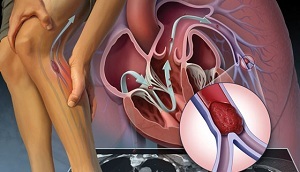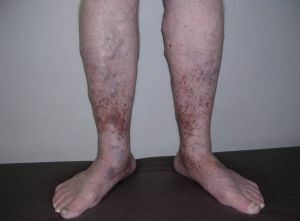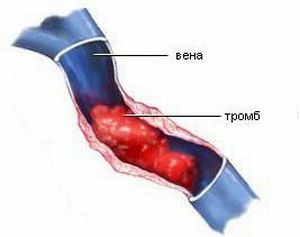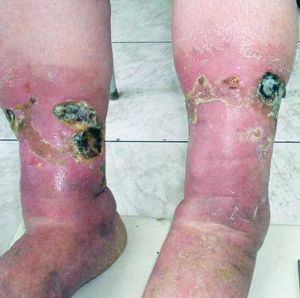 Post-thrombophlebitic syndrome( shortened PTFs) is a hard-to-treat, chronic venous pathology that is caused by deep vein thrombosis of the lower extremities.
Post-thrombophlebitic syndrome( shortened PTFs) is a hard-to-treat, chronic venous pathology that is caused by deep vein thrombosis of the lower extremities.
This complication occurs according to different estimates in 5-28% of patients with venous pathology and is expressed by trophic skin disorders, obvious edema and secondary varicose veins.
The disease develops within five to six years after the first case of leg thrombosis.
Content
- Causes of
- syndrome Signs and symptoms of various forms of the syndrome
- Diagnostic approach
- Therapies
- Drug therapy
- Surgery Possible complications
- Preventive measures
Causes of
main root cause of the syndrome of post-thrombotic syndrome is a blood clot forming in the deep veins. In severe forms, the vessel is completely clogged, and full vein obstruction occurs.
Approximately 14-20 days after the formation of the thrombus, it begins to resolve, and the connective tissue forms on the walls of the vein.
As a result, the vein loses the valvular apparatus and becomes similar to the tube, the intravenous pressure rises and blood circulation in the leg is disturbed.
In nine out of ten cases, these irreversible changes have a negative effect on the lymph system and a maximum of six years lead to PTFs.
Eczema appears on the skin, sclerosing subcutaneous tissue. With further complication, trophic ulcers are formed.
Symptoms and signs of different forms of the
syndrome. A person who has noticed the following symptoms should immediately seek medical help:
- on his legs appeared tubercles on the veins or vascular asterisks;
- has strong and long swelling of the lower limbs;

- feet quickly get tired, they feel heavy;
- there are cramps;
- decreased sensitivity of the limbs;
- after walking or standing the legs grow numb;
- in the future, swelling is worse, first the knee is swollen, then the rest of the leg;
- skin may become darker, stained;
- every tenth patient develops trophic ulcers.
Due to the presence and severity of symptoms, the postthrombophlebitic syndrome occurs in forms that can change one another:
- varicose;
- edematous-painful;
- is ulcerative;
- mixed.
Diagnostic approach
 To diagnose the syndrome, it is necessary to examine the patient, carry out Pratt, Delbe-Perthes and others, ultrasound.
To diagnose the syndrome, it is necessary to examine the patient, carry out Pratt, Delbe-Perthes and others, ultrasound.
Especially ultrasound allows you to determine the degree of lesion of the vein, see the localization of the thrombus, the obstruction of the vein, the efficiency of the valve and evaluate how the vessel functions.
If at this stage there is a lesion of the femoral or iliac veins, then a pelvic phlebography will be needed. According to the doctor's decision, plethysmography can be prescribed.
Methods of treatment of
PTFs and concomitant venous insufficiency can not be cured 100%.
The main goal of the treatment is slowing the development of pathology and alleviating the patient's condition. For this, the following treatment methods are used:
- compression therapy - wearing special underwear and bandaging of the leg with elastic bandages;
- lifestyle correction - rejection of bad habits, normal nutrition, motor activity;

- drug therapy - taking anti-inflammatory drugs and improving the condition of veins that prevent the appearance of new blood clots;
- topical treatment of - the use of ointments, gels and creams that heal ulcers;
- physiotherapy - normalizes blood circulation in the leg, improves skin metabolism;
- surgical intervention - is performed to remove blood clots and prevent the "creeping" of pathology to other veins.
Radical surgery is used in most cases of postthrombophlebitic syndrome. One conservative therapy is used only if the disease progression is positive, or if the patient has serious contraindications to surgical intervention.
Let us consider in more detail some details of the treatment.
Drug therapy
For the treatment of venous insufficiency with PTFs, drugs that normalize the blood circulation, protect the walls of the vessels from damage, stabilize lymph drainage, preventing the leukocytes from leaving into soft tissues.
Medication therapy usually lasts about two months.
Russian doctors usually use a technique divided into three stages:
- The first stage involves the use of disaggregants, antioxidants, vitamin B6, anti-inflammatory non-steroid drugs. If the patient has trophic ulcers, then antibacterial drugs are prescribed. This stage of treatment lasts 7-10 days.
- In the second stage, along with the disaggregants designate reparants and polyvalent phlebotobiotics. The duration of the second stage is 2-4 weeks.
- The third stage of drug treatment shows polyvalent phlebotonics and topical preparations. It is necessary to apply them not less than one and a half months.
The curative scheme may include light fibronolytics, diuretics, Aspirin, Dipyridamole.
If there are trophic pathologies - antihistamines, and for dermatitis and allergic reactions, consultation and treatment with a dermatologist is mandatory.
Only an experienced doctor on the basis of a serious diagnosis can prescribe adequate medication.
Surgical treatment
In postthrombophlebitic syndrome, various types of surgical intervention can be performed - the method is selected individually according to the diagnostic and clinical data.
Most often, the intervention is performed on the superficial and communicative veins after the blood flow in the deep vessels has been restored( recanalization has been carried out).Before it is completed, surgery on the subcutaneous veins can worsen the condition. Therefore, to operations of this kind of patient should be carefully prepared.
Most often used:
- Sometimes a special technique of Psatakis is used to restore the venous valve. In the popliteal vein, a valve mechanism is simulated from the tendon of the patient himself, squeezing the diseased vein while walking.
- Operation The palm is performed with iliac veins. This creates a shunt between the normal and the affected vein. This technique can be supplemented by superimposing arteriovenous fistulas.
- If occlusion of veins in the hip-popliteal segment, can be performed bypassing the removed tissues of the with a special graft. They can also perform an operation resection of recanilized vessels.
- To eliminate stagnation of blood and venous hypertension, can be recommended for , with some veins ligated for Felder, Coquette or Linton.
In modern medicine, there are many ways to correct the affected venous valves. If it is impossible to restore the valvular apparatus, then a healthy vein transplant is performed. As such, the site of the axillary vein is taken.
Possible complications of
 Trophic ulcers, being open wounds, can serve as sources of penetration of all kinds of infections.
Trophic ulcers, being open wounds, can serve as sources of penetration of all kinds of infections.
In the absence of treatment, serious complications such as gangrene and tissue necrosis can occur.
The formation of blood clots and vasoconstriction leads to a general deterioration of well-being, often to an increased risk of developing heart attacks and strokes.
Possible death!
Preventative measures
For people who work mostly sitting or standing, every hour it is necessary to take a break for five minutes to warm up: walk up the stairs, make the feet turn, raise your legs in the back of a chair or table.
Also necessary:
- Drink plenty of fluids.
- In the evenings or after exercise, do foot massage.
- Take a contrast shower or make foot baths with essential oils.
- Properly eat so that there is no excess weight. Preferably healthy vegetable food, especially useful for vessels of garlic. Avoid excessive consumption of products leading to blood thickening.
- Refuse bad habits: smoking and alcohol abuse.
- In patients at risk, use drug prophylaxis: Aspirin and low molecular weight heparins as prescribed by the doctor.
Postthrombophlebitic syndrome is difficult to treat. Careful and patient adherence to all the recommendations of a doctor is the main recipe for this complex disease.
The earlier a person falls ill, the better the result. Therefore, with the least disturbing signs it is necessary to contact specialists, and to avoid the occurrence of venous insufficiency - to observe the above-described, not at all complicated preventive measures.
